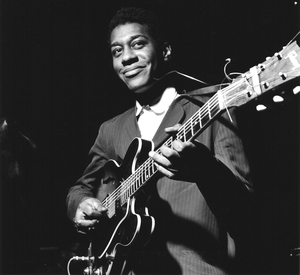Grant Green facts for kids
Quick facts for kids
Grant Green
|
|
|---|---|
 |
|
| Background information | |
| Born | June 6, 1935 St. Louis, Missouri, U.S. |
| Died | January 31, 1979 (aged 43) New York City |
| Genres |
|
| Occupation(s) |
|
| Instruments | Guitar |
| Years active | 1959 – 1978 |
| Labels |
|
| Associated acts |
|
Grant Green (born June 6, 1935 – died January 31, 1979) was an American jazz guitarist and composer. He was known for his unique guitar style.
Grant Green recorded many albums for Blue Note Records. He played different types of jazz, including hard bop, soul jazz, and bebop. Many critics say he was one of the greatest jazz guitarists. They describe his sound as smooth, relaxed, and a bit bluesy. He often played in a small group called an organ trio. This group included a Hammond organ and a drummer.
Green's main musical influences were saxophonists, especially Charlie Parker. Because of this, he often played single notes in a line, like a saxophone. He rarely played rhythm guitar (chords) unless he was helping other musicians. His playing was simple and direct. This came from his early experience playing rhythm and blues. He was also very good at playing blues and funk music.
Contents
Early Life and Music
Grant Green was born in St. Louis, Missouri, on June 6, 1935. His parents were John and Martha Green. His father played blues and folk music.
Grant started learning guitar when he was in primary school. His father taught him some basics. He also learned a lot by listening to records. He studied with Forrest Alcorn for one year.
At 13, he began playing professionally in a gospel music group. He was influenced by guitarists like Charlie Christian and saxophonists like Charlie Parker. He first played boogie-woogie music. Later, he moved on to jazz.
Career Highlights
Grant Green made his first recordings in St. Louis. He played with tenor saxophonist Jimmy Forrest. Drummer Elvin Jones also played with them. Green recorded with Jones on several albums later on.
In 1959, jazz musician Lou Donaldson discovered Green playing in a bar. Donaldson hired him for his touring band. Green then moved to New York City.
Lou Donaldson introduced Green to Alfred Lion, who ran Blue Note Records. Lion was very impressed with Green. He decided to let Green record as a band leader right away. This was unusual for new artists at Blue Note. Green's first recording session was released much later, in 2001. It was called First Session.
Green's recording career with Blue Note lasted through most of the 1960s. From 1961 to 1965, he appeared on more Blue Note albums than anyone else. He was a leader or a sideman on many recordings.
Green's first album released as a leader was Grant's First Stand. That same year, he released Green Street and Grantstand. In 1962, Down Beat magazine named Grant the best new star. He often played with other important Blue Note musicians. These included saxophonists Hank Mobley and Stanley Turrentine. He also played with organist Larry Young.
Some of Green's albums had special themes. Sunday Mornin', The Latin Bit, and Feelin' the Spirit explored gospel, Latin, and spiritual music. Critics say Idle Moments (1963) and Solid (1964) are some of his best works. These albums featured musicians like Joe Henderson and Bobby Hutcherson.
Many of Grant Green's recordings were not released when he was alive. These include albums with pianist Sonny Clark. Also, two albums from 1964, Matador and Solid, featured McCoy Tyner and Elvin Jones. They were from the famous John Coltrane Quartet.
In 1966, Green left Blue Note. He recorded for other labels, like Verve. In 1969, he came back with a new band that played funk music. His albums from this time include the popular Green Is Beautiful. He also recorded the music for the film The Final Comedown.
Green left Blue Note again in 1974. His later recordings are sometimes called the start of Acid Jazz. His music from this period has been used by artists like US3 and A Tribe Called Quest.
Later Years and Legacy
Grant Green spent much of 1978 in the hospital. Even though doctors advised against it, he went back on tour to earn money. He was in New York to play a show when he had a heart attack in his car. He passed away on January 31, 1979.
He was buried in Greenwood Cemetery in St. Louis, Missouri. He had six children, including his son Grant Green Jr., who is also a guitarist. Since his death, Grant Green's music has become even more popular. Many collections of his earlier and later music are now available.
Equipment
Grant Green used several different guitars. He played a Gibson ES-330 and a Gibson L7. He also used an Epiphone Emperor. Later, he had a special guitar made for him by D'Aquisto.
Another guitarist, George Benson, said that Grant got his special sound by turning off the bass and treble on his amplifier. He would turn up the middle sound. This gave him his strong, clear guitar tone.
Discography
See also
 In Spanish: Grant Green para niños
In Spanish: Grant Green para niños

